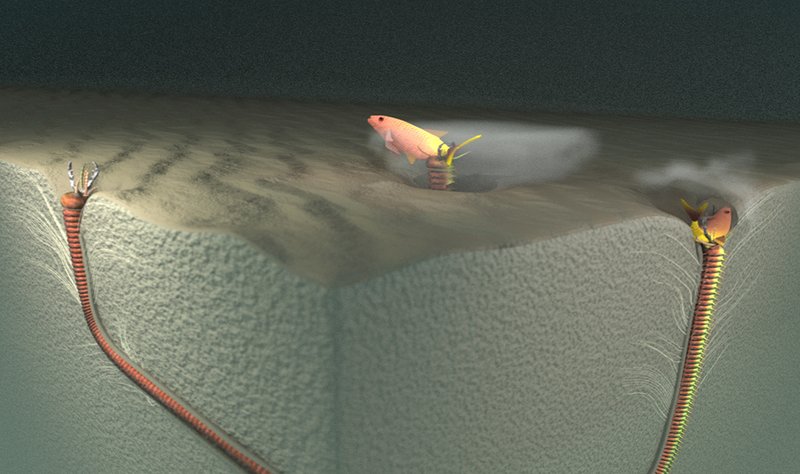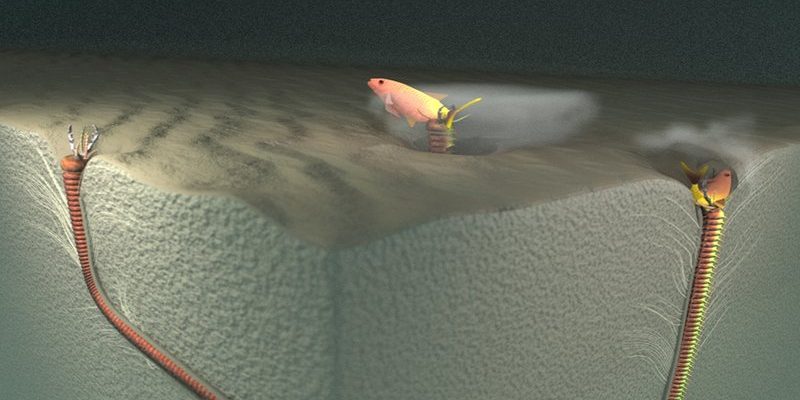
Now, if you’re new to marine biology or just want to impress your friends with your knowledge, let’s dive deeper into the world of Bobbit worms. These fascinating creatures create distinct holes in the seabed, but they aren’t the only ones making their mark in the sand. There are a variety of burrows out there, from those made by other marine life to simple depressions left by waves. So, how can you tell the difference? That’s what we’re here to explore.
What Are Bobbit Worms?
Bobbit worms, or *Eunice aphroditois*, are marine polychaete worms known for their impressive size and predatory nature. They can grow up to 10 feet long! Imagine a worm that not only looks long but can also strike with lightning speed to snag unsuspecting prey. These worms typically inhabit sandy or muddy substrates and use their burrows as hiding spots and ambush points for capturing fish and other small creatures.
When you see a Bobbit worm in action, it might remind you of a snake hiding in the grass, waiting for lunch to wander by. With their ability to blend into their surroundings, these worms are masters of deception. Their unique anatomy includes a specialized head with sharp jaws and a segmented body that helps them maneuver through their narrow tunnels.
What’s fascinating is that Bobbit worms are not just solitary predators; their burrows can also serve as a habitat for other organisms. This mutual relationship illustrates the complexity of marine ecosystems. So, recognizing their burrows can give you insights into more than just the Bobbit worm itself.
Recognizing Bobbit Worm Holes
Now that we’ve got a handle on what Bobbit worms are, let’s look at their burrows. The holes made by these creatures are quite distinctive! Generally, you’ll find them about the size of a pencil or sometimes even larger. They often appear as small, straight or slightly curved tubes in the substrate. Understanding these features will help you differentiate them from other burrows.
One of the most striking characteristics of a Bobbit worm hole is its smooth, clean appearance. Unlike burrows created by other creatures, which can be irregular or messy, Bobbit worm holes tend to maintain a neat structure. If you see a straight, tapered hole that seems to go straight down into the sand, you’re likely looking at a Bobbit worm home.
Another telltale sign is the presence of sediment around the entrance. Bobbit worms often eject waste or leftover food particles from their burrows, leading to a small mound or ring of debris around the hole. This is a good clue to keep in mind as you examine potential burrows.
Comparing Bobbit Worm Holes to Other Burrows
When you’re on the beach or diving in shallow waters, you might come across a few different types of burrows. Some other species, like sand dollars or sea cucumbers, also create holes in the sand. However, their burrows look very different from those of Bobbit worms.
For instance, sand dollar burrows are typically shallow and circular, almost like a little crater, rather than deep, straight holes. Meanwhile, sea cucumbers might create larger depressions that don’t have the same smooth, tube-like structure. Observing the overall shape and depth can help you quickly rule out what you’re looking at.
Another way to differentiate these burrows is to look at their location. Bobbit worms prefer sandy or muddy substrates in deeper waters, while other marine animals might dig in shallower or rockier environments. Understanding these preferences can help refine your search and increase your chances of spotting a Bobbit worm burrow.
Environmental Factors Influencing Burrow Appearance
The environment plays a crucial role in how burrows appear. Water conditions, such as currents and wave action, can alter the shape and stability of holes. For instance, in more turbulent areas, the burrows might collapse or wash away, leading to less visible entrances. Conversely, calmer waters help maintain the integrity of Bobbit worm holes, making them look more defined.
Additionally, sediment type affects how well burrows hold their shape. Fine sand allows for smoother, cleaner holes, while coarse sand may lead to more irregular burrows. Being aware of these environmental factors can inform your search strategy.
You might also notice that during certain times of the year, Bobbit worms are more active. They may dig new burrows or maintain existing ones, which can lead to observable changes in their appearance. Keeping an eye on seasonal patterns will help enhance your understanding of where to find these fascinating creatures.
Common Mistakes When Identifying Burrows
When searching for Bobbit worm holes, it’s easy to make a few common mistakes. One typical error is mistaking other marine life for Bobbit worms simply because they have a hole. For example, *Nereis* worms or other polychaetes may create similar-looking structures that can confuse the untrained eye.
Another mistake is assuming all deep holes indicate the presence of Bobbit worms. Some fish dig holes in the sand to create nests or lay eggs, and these can also be quite deep. Remember, the *smoothness* and *straightness* of the hole are key indicators that it’s a Bobbit worm burrow.
Lastly, not paying attention to the surrounding environment can lead to misidentification. If a burrow is present near rocky areas or coral reefs, it may belong to entirely different creatures. Always look at the bigger picture when analyzing potential burrows.
Why Knowing Bobbit Worm Holes Matters
Understanding how to differentiate Bobbit worm holes from other burrows isn’t just for fun; it’s vital for marine conservation efforts. These worms play a significant role in their ecosystems by recycling nutrients and providing habitats for other organisms.
By recognizing their burrows, you can contribute to citizen science efforts and reporting on marine life. This data is valuable to researchers studying the health of marine environments and the impact of human activities.
Plus, knowing how to spot a Bobbit worm hole can enhance your experience while exploring marine life. It adds an exciting layer to your beachcombing adventures or underwater excursions. You’ll find yourself more engaged with the environment and its inhabitants, deepening your appreciation for the ocean’s wonders.
Final Thoughts on Bobbit Worm Holes
In summary, learning how to distinguish Bobbit worm holes from other burrows can open up a whole new world of marine exploration. With their distinct characteristics and interesting ecology, Bobbit worms are truly remarkable creatures. Whether you’re a beach enthusiast or a budding marine biologist, understanding their unique burrows enhances your experience and deepens your connection to ocean life.
Armed with the information above, you’re now better equipped to identify Bobbit worm holes on your next beach trip or diving adventure. Remember to take your time, observe the environment, and enjoy the journey of discovery. Happy exploring!

